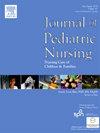Healing ceilings: A collaborative exploration of pediatric preferences in ceiling tile artwork
IF 2.1
4区 医学
Q2 NURSING
Journal of Pediatric Nursing-Nursing Care of Children & Families
Pub Date : 2025-03-01
DOI:10.1016/j.pedn.2025.02.005
引用次数: 0
Abstract
Aim
While incorporating artwork within healthcare settings can improve health outcomes, limited research exists to guide art selection for pediatric patients. This study aimed to improve an ongoing collaboration between a healthcare system and local art museum through which community members painted 100 custom ceiling tiles for display in pediatric clinical areas. The researchers sought to determine if artwork content and/or color tone impacted patient experience and/or preference of artwork.
Methods
Nursing directors surveyed 65 patients within the healthcare system's children's hospital on their experiences and preferences of ceiling tile artwork. Patients in “young” (4–7 years), “middle” (8–11 years), and “older” (12–17 years) age groups were asked whether they felt “better,” “worse,” or “no different” when viewing images within each of six artwork content categories and three color tone categories. Patients who felt “better” were invited to complete the Five Degrees of Happiness Scale to determine preference of artwork content and color tone.
Results
Overall, patients responded positively to viewing the images. The most positive experience resulted from artwork featuring realistic nature, realistic animal, and cartoon content. Patients tended to have a more positive experience of and greater preference for bright color tones. Younger children reported the best experience overall.
Conclusion
Pediatric patient feedback informed the design and installation of ceiling tiles toward greatest patient experience. Patients' enthusiasm to participate in this study suggests the benefits of involving children's feedback in healthcare design include relational aspects of care.
求助全文
约1分钟内获得全文
求助全文
来源期刊

Journal of Pediatric Nursing-Nursing Care of Children & Families
NURSING-PEDIATRICS
CiteScore
3.70
自引率
8.30%
发文量
291
审稿时长
65 days
期刊介绍:
Official Journal of the Society of Pediatric Nurses and the Pediatric Endocrinology Nursing Society (PENS)
The Journal of Pediatric Nursing: Nursing Care of Children and Families (JPN) is interested in publishing evidence-based practice, quality improvement, theory, and research papers on a variety of topics from US and international authors. JPN is the official journal of the Society of Pediatric Nurses and the Pediatric Endocrinology Nursing Society. Cecily L. Betz, PhD, RN, FAAN is the Founder and Editor in Chief.
Journal content covers the life span from birth to adolescence. Submissions should be pertinent to the nursing care needs of healthy and ill infants, children, and adolescents, addressing their biopsychosocial needs. JPN also features the following regular columns for which authors may submit brief papers: Hot Topics and Technology.
 求助内容:
求助内容: 应助结果提醒方式:
应助结果提醒方式:


